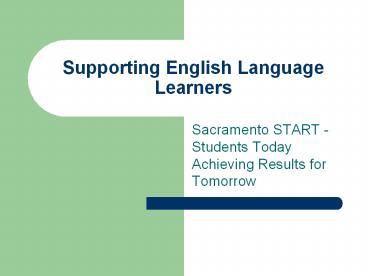Supporting English Language Learners Sacramento START - PowerPoint PPT Presentation
1 / 17
Title:
Supporting English Language Learners Sacramento START
Description:
Supporting English Language Learners Sacramento START - Students Today Achieving Results for Tomorrow Sacramento START START- Students Today Achieving Results for ... – PowerPoint PPT presentation
Number of Views:33
Avg rating:3.0/5.0
Title: Supporting English Language Learners Sacramento START
1
Supporting English Language Learners
- Sacramento START - Students Today
Achieving Results for Tomorrow
2
Sacramento START
- START- Students Today Achieving Results for
Tomorrow - Part of City of Sacramento, Parks and
Recreation Department - 46 Schools in five districts
- Serving 5,000 children daily
- Program has been in existence for 16 years
3
Demographic data for Sacramento START from our
2009/2010 Program Evaluation Report
- Gender breakdown is 50
- Ethnic groups include
- Hispanic students were largest group at 36
- African American students at 28
- Asian Americans at 15
- English Learners were 29
- Free and Reduced Meal participation rates were
77 of START students
4
What We Know About English Learners and After
School
- California highest school enrollment of English
Learners compared to any other state - According to the Master Plan for California After
School Programs, ASES and 21st Century Community
Learning Centers are located in schools with a
high percentage of English Learners. - English Learners may not have adequate
instructional time during the school day and
After School programs are able to extend the
amount of time the students spend learning
English. - English Learners speak English about 2 minutes
during the school day. The After School
environment provides a gift of time for those
students to practice English by speaking,
listening, writing and reading.
5
EL Success in School and Beyond
- What it takes
- Practice
- Supportive environment for risk-taking
- Motivation to communicate
- Diverse experiences
- Techniques to enhance and expand understanding
and effective communication - Motivation to communicate
- Diverse experiences
6
Afterschool English Learners
- Unique features for teaching and learning
- More opportunities to practice English
- Learn new vocabulary
- Homework help
7
Afterschool English Learners
- Supporting additional needs, making
- connections
- Learning social norms
- Building meaningful relationships with adults and
children - Link to school, home and the community
- Greater family engagement
8
How We Support English Learners
- Training team participated in seminars on
Leveraging Support for English Learners - Professional development trainings for our staff
- Purchased curriculum for each site
- Collaborated with Academic Alignment Coach from
each school who completed the English Learner
Form
9
How We Support English Learners
- Establish a relationship with each child
- Create a safe environment
- Ask all children to speak in complete sentences
- Group children in a deliberate manner so EL
students are with Native English speaking
children - Ask the children to teach you words in their
native language. - Place our diverse staff at sites where they can
communicate with the children and parents in
their native language.
10
How We Support English Learners
- Wait several seconds after asking a question for
the child to answer - If the child does not answer, repeat the question
with hints so the child will be able to answer
successfully - Do not over correct children as that happens in
the daytime. - Focus on comprehension over reading each word
correctly.
11
Supporting EL Students Staff Instructional
Resource Language Acquisition Descriptors
CEDLT Level 1 Beginning Key Strategy Listening!
Listening! Listening!-Books on tape, read-alouds,
choral reading, buddy reading
Beginning vocabulary is best understood and
learned when taught thematically
12
Supporting EL Students Staff Instructional
Resource Language Acquisition Descriptors
CEDLT Level 2 Early Intermediate Key Strategy
Beginning vocabulary is best understood and
learned when taught thematically
Appropriate questioning techniques will
increase student oral production i.e., using the
answer as part of the question i.e., (Did you go
to the grocery store or to the library?)
13
Supporting EL Students Staff Instructional
Resource Language Acquisition Descriptors
CEDLT Level 3 Intermediate Key Strategy At
this level, oral communication skills are more
highly developed. Using cooperative groups
during instruction will help students develop
their higher levels of thinking while increasing
their vocabulary and comprehension.
14
Supporting EL Students Staff Resource Language
Acquisition Descriptors CEDLT Level 4 Early
Advanced Key Strategy Students have a strong
conversational vocabulary but still need an
emphasis on academic vocabulary
15
Supporting EL Students Staff Resource Language
Acquisition Descriptors CEDLT Level 5
Advanced Key Strategy Provide multiple
opportunities for student to participate in
cooperative learning groups and take on
leadership roles.
16
Site Name_________________________________________
START EL Form
17
Sacramento START
- Beryl Johnson, Training Coordinator
- bbjohnson_at_cityofsacramento.org
- Shirley Rosenbloom, Academic Resource Teacher
- srosenbloom_at_cityofsacramento.org

